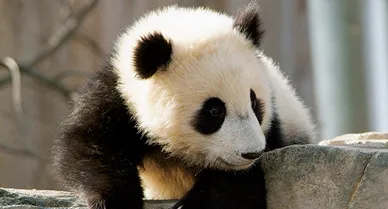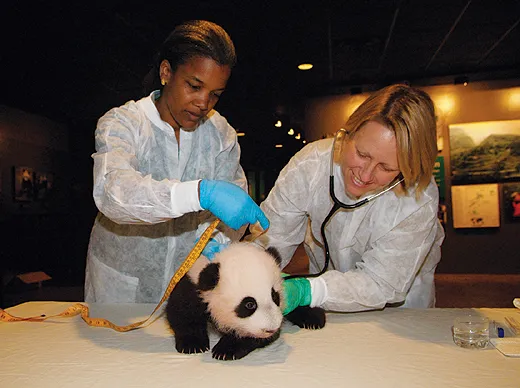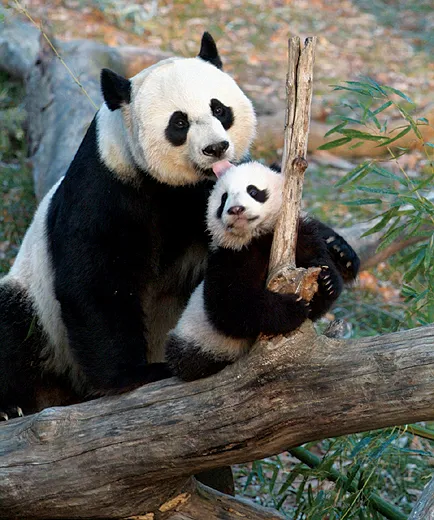Learning from Tai Shan
The giant panda born at Washington, D.C.’s National Zoo has charmed animal lovers. Now he’s teaching scientists more than they had expected
In a cramped, dimly lit room, three women stare at a bank of blinking video monitors. Each of the six screens shows, from a slightly different angle, a black-and-white ball of fluff—Tai Shan, the giant panda cub born last summer at Smithsonian’s National Zoo. Every two minutes, at the ring of a bell, the volunteer researchers write down what the cub is doing. Ding! Sleeping. Ding! A yawn. Ding! The right front paw twitches. For the first two months of Tai Shan’s life, Zoo staff and volunteers monitored him 24 hours a day. He is one of the most closely studied pandas in history.
He’s also one of the capital’s biggest celebrities. In December, when the cub made his public debut, 13,000 free tickets to see him were snapped up on-line in two hours. Fans lined up in subfreezing temperatures before the ticket booth opened for a chance at the additional 60 tickets handed out each day. More than 200,000 people voted on the cub’s name—Tai Shan (tie-SHON) means “peaceful mountain”—while millions logged onto the Zoo’s live “panda cam” (nationalzoo.si.edu/Animals/GiantPandas).
The Zoo’s first surviving panda cub, and only the fourth nationwide, Tai Shan “is the culmination of a decade of collaborative research between the United States and China,” says David Wildt, chairman of the Zoo’s reproductive sciences department. In 2005, twenty-one cubs born in captivity survived (two in the United States, one in Japan and the rest in China), more than twice as many as survived in 2004 and more than any other year to date. That achievement, along with new panda reserves and other conservation measures in China, are upping the odds that one of the world’s most endangered—and most beloved—creatures will survive, not just in captivity but in the wild.
As recently as two decades ago, the panda’s future looked bleak. Restricted to remote, mist-shrouded bamboo forests in mountainous southwestern China, the bears had lost more than half of their habitat by the late 1980s. For centuries, logging and farming had pushed pandas to steeper and higher terrain. The species’ population was down to an estimated 1,000 animals scattered among two dozen isolated groups. Although another hundred or so pandas were kept in Chinese breeding centers, their reproductive rate was so low they offered little hope for replenishing dwindling numbers. By 1997, only 26 percent of captive pandas had ever bred.
Pandas are notoriously difficult to breed. Females ovulate just once a year and remain fertile for only one or two days. Most captive males, meanwhile, are either uninterested in sex or are so aggressive that they pose a danger to fertile females. Even when both partners seem willing, males are often unable to consummate the affair. It was a decade before the Zoo’s first panda pair, Ling-Ling and Hsing-Hsing, finally mated, in 1983, after years of fumbling, misdirected embraces. Ling-Ling and Hsing-Hsing—goodwill gifts from China commemorating President Richard Nixon’s 1972 visit—produced five cubs during their two decades together at the Zoo, but none lived longer than a few days.
In the 1970s, scientists at the Beijing Zoo pioneered techniques to artificially inseminate pandas, and they produced their first cub in 1978. But the procedure had a high failure rate, and only a small percentage of the cubs born in captivity in China, whether conceived artificially or naturally, survived as long as a year. The bear’s prospects began to look up in 1996, when Chinese officials invited a group of U.S. scientists experienced in breeding other endangered species to collaborate on giant panda research. The United States was to provide much of the science and technical know-how, while China would contribute knowledge gained through decades of panda studies and, of course, provide the actual animals. “We jumped at the opportunity,” recalls National Zoo reproductive physiologist JoGayle Howard, who had logged countless hours trying to make Ling-Ling a mom.
Beginning in 1998, U.S. scientists began traveling regularly to China, where they and their Chinese colleagues assessed the health, reproduction, genetics, behavior and nutrition of 61 animals at China’s three largest breeding centers, in Wolong, Chengdu and Beijing. The survey’s most surprising finding was that 80 percent of the pandas, even those that had been dismissed as “poor breeders,” were in fact “healthy, reproductively competent animals that had potential to contribute to the captive population,” says Wildt. A decade later, most of those animals are indeed contributing, thanks to the surge in panda science spawned by the collaboration. “Today,” Wildt adds, “we know more about the biology of the giant panda than we do about any other endangered species in the world.”
The giant panda is a biological oddity. A member of the bear family, Ailuropoda melanoleuca (“black and white cat-footed bear”) diverged from the main bear lineage 15 million to 25 million years ago. In addition to its bold markings, the panda has a larger and rounder head than any other bear. Like other bears, pandas are solitary creatures, except for mothers and their cubs, which stay together for up to two years. The most unusual thing about the giant panda is its diet. Unlike other ursids, which rely at least in part on insects, fish, mammals or other meat, pandas are vegetarians. Stranger still, 99 percent of the bear’s diet consists of bamboo, a grass. A panda might appear well suited to its bamboo diet. The animal’s large jaw is equipped with powerful chewing muscles and large, flat molars that grind down the tough grass. Its paws sport opposable “thumbs”—actually elongated wrist bones—allowing a panda to hold a bamboo stalk while munching it. (The animals usually do this while seated in a remarkably human-like position, one of the traits people find so appealing about pandas.) But a panda’s digestive system lacks the specialized gut that cows and deer have to break down grass efficiently. This means the bears must spend about 14 hours a day eating up to 40 pounds of bamboo. Adults weigh between 185 and 245 pounds. Because pandas aren’t able to accumulate much fat, they cannot afford to take the winter off to hibernate, unlike Asiatic black bears that live in the same habitat. “The panda’s dependence on bamboo drives its entire physiology and ecology,” says National Zoo animal nutritionist Mark Edwards.
Unlike polar bears and grizzlies, which travel long distances to find food, pandas can stay close to home. “Essentially, they’re living in their own salad bowl,” says Edwards. But the animal’s diet also makes it vulnerable to bamboo die-offs, which occur naturally every 40 to 100 years after the plants flower. In the past, when one bamboo stand died, pandas simply migrated to another. But most of the species’ habitat has been destroyed or fragmented, threatening to strand the bears.
The giant panda’s dependence on bamboo may even help explain its unusual reproductive system. When a female becomes pregnant, the fertilized egg does not immediately attach to the uterine wall, as it does in most mammal species. Instead, the embryo floats within the reproductive tract for many months, attaching only about 45 days before the cub’s birth. Edwards suspects a female cannot build up enough nutrients from bamboo to support a fetus for any longer. As a result, newborn cubs have only just begun to develop. Pink and hairless, they weigh about a quarter of a pound, or the same as a stick of butter. (Hence Tai Shan’s nickname, Butterstick.) Compared with the size of the mother, “no other non-marsupial mammal has a smaller offspring,” says Edwards.
Pandas give birth to twins about half the time. This itself is not unusual—most bears have twins or triplets—but a panda mother usually selects one of her two cubs to raise and lets the other die. Biologists once believed that such an apparently illogical act occurred only in captivity. But in fieldwork conducted at Wolong Nature Reserve in the late 1980s, biologist Pan Wenshi often found a dead cub near a mother that was caring for a healthy one. Scientists speculate that new panda mothers just can’t afford to feed two cubs—another behavior that may be an evolutionary adaptation to the animals’ low-energy diet.
Tai Shan’s story begins in 2000, when his mother, Mei Xiang (may-SHONG), and father, Tian Tian (t-YEN t-YEN), came to the National Zoo on a ten-year loan from China made possible through major sponsorships by Fujifilm and Animal Planet and other donors. (Three other U.S. zoos—in San Diego, Atlanta and Memphis—also host pandas; in exchange, each institution must contribute at least $1 million per year to panda conservation in China.) In 2003, as the bears were just reaching sexual maturity at ages 5 and 6, they mated for the first time, but no pregnancy followed. The next year, after the pandas tried unsuccessfully to mate on their own, Zoo scientists inseminated Mei Xiang with Tian Tian’s sperm, again without conception.
Last spring, as Mei Xiang began to show signs that she was coming into estrus, the scientists prepared to place Tian Tian’s sperm directly into her uterus. Because the procedure would require Mei Xiang to undergo general anesthesia—which always carries a risk—they decided to try the insemination just once, a considerable gamble given how briefly a female is fertile. “In China, we learned just how narrow the window of opportunity is,” says JoGayle Howard, who performed the procedure.
Recent studies have fine-tuned techniques to predict that 24- to 48-hour period. One is to analyze vaginal cells. In exchange for a reward—a biscuit, apple or pear—Mei Xiang has been trained to enter her 5- by 4-foot training cage and submit to all manner of pokes and probes. Zoo technicians examine cells swabbed from her vagina to tell how close to ovulation she is. They also siphon her urine off the enclosure floor. National Zoo endocrinologists Steve Monfort and David Kersey analyze these samples for changes in estrogen levels.
The big day turned out to be March 10, 2005. Earlier that week, Mei Xiang had increased her frequency of “scent marking,” or rubbing a gland near her tail against the ground to deposit a sticky substance with an odor detectable by other pandas. Zoo scientists were monitoring her urine and vaginal cells round-the-clock. When tests showed Mei Xiang was ovulating, they first gave Tian Tian an opportunity to do the job himself. But after 24 hours—during which he “hadn’t achieved the proper alignment,” says assistant curator Lisa Stevens—the scientists took over.
To get Tian Tian’s sperm, the researchers anesthetized him and used an animal breeding technique called electroejaculation, in which a probe inserted into the male’s rectum produces electrical stimulations that cause ejaculation. For the insemination, Howard used a modified laparoscope (a tiny telescope with a fiber optic light often used in human medicine) to guide a catheter through Mei Xiang’s cervix and into her uterus. “We felt the timing was right on,” says Howard. “The procedure couldn’t have gone faster or more smoothly, and that’s what made me nervous.”
Zoo scientists wouldn’t know whether they had succeeded for nearly four months: giant pandas frequently go through “pseudopregnancies” in which non-pregnant females exhibit behavioral and hormonal changes similar to those of pregnant females. (And given the tiny size of a panda fetus, the pregnancy doesn’t show.) “I didn’t relax until that cub was on the ground,” says Howard. That was at 3:41 a.m. on July 9, 2005. Still, Howard wasn’t ready to uncork the champagne. In addition to routinely rejecting a twin, panda moms have been known to ignore single cubs. Says Howard: “They either act like they’re scared of it or look like they’re thinking, ‘I’m not taking care of that thing,’ and walk away.”
But just two minutes after giving birth, Mei Xiang gently picked up tiny Tai Shan and began to cradle and cuddle him. For the following week, she refused to leave their “den”—a darkened 10- by 12-foot room—even to eat or drink. On the 7th day, she left him (for three minutes) to get a drink of water; she did not eat until day 17. “From the beginning, Mei Xiang couldn’t have been a more perfect mother,” says Howard. “And Tai Shan couldn’t be a healthier cub.”
The most important reason for keeping pandas in captivity—beyond public education, research and fundraising—is to prevent their extinction in the wild. Captive populations of endangered animals are insurance, should the species vanish in its native habitat, and a potential source of animals for reintroductions into the wild. But captive populations are prone to inbreeding, a major threat to their survival. U.S. and Chinese scientists now meet before each spring’s breeding season to recommend the best panda pairings to ensure a diverse mix of genetic backgrounds, and most breeding centers move animals or their sperm from one institution to another as needed. Giant pandas have an advantage over other endangered species, such as the black-footed ferret and the California condor, whose numbers fell so low that inbreeding could not be avoided. “We know we’re growing a genetically healthy population of pandas,” says Wildt. According to National Zoo population manager Jonathan Ballou, the next step is to increase the number of captive pandas until the population is self-sustaining. He calculates that the magic number is 297 pandas; today there are 185, an all-time high.
Most scientists say it is not time yet to return captive pandas to the wild. Reintroduction is risky to the captive-born animals and potentially to any wild pandas they might fight with or infect with diseases. And what’s left of the panda’s habitat is not yet secure.
There’s no question the species’ prospects in the wild have improved. Eight years ago, China banned logging in all forests within the panda’s range. To curb erosion, the government’s six-year-old Grain-to-Green Program pays farmers cultivating land on slopes steeper than 30 degrees to leave those fields fallow or plant trees—a policy that also benefits mountain-dwelling pandas. About 60 reserves are set aside for pandas today, up from 13 in the early 1990s. Such measures seem to be helping: a 2004 panda survey by the State Forestry Administration of China and the World Wildlife Fund reported that about 1,600 pandas remain in the wild, which appears to be an increase since the 1980s.
U.S. zoos are beginning to direct larger portions of their panda funds to conserving the animals in the wild. Of the $1.4 million that the National Zoo pays China annually, about $200,000 supports fieldwork. Zoo staff have trained hundreds of Chinese conservation professionals in techniques such as using satellites to assess habitats and setting heat-sensing camera “traps” to document animals. In the past year, the cameras have snapped their first photos of giant pandas (along with nearly 25 other mammal species). Researchers are eager to outfit some pandas with radio transmitters to track their movements, but China has stopped granting permission for such studies in recent years, worried the practice might harm the animals. The decision has slowed research in pandas’ native habitat, some of the steepest and most difficult to traverse forests in the world. “Radio telemetry is how we learn about wildlife,” says National Zoo ecologist William McShea. “At least 80 percent of what’s known about black, polar and grizzly bears, for example, is based on radio tracking of the animals.”
Other scientists are working to restore panda habitat. The Memphis Zoo, whose pandas Ya Ya and Le Le are just now approaching sexual maturity, is spending part of its panda fees to restore 2,000 acres of bamboo forest adjacent to Foping Nature Reserve, in Shaanxi Province, which has the highest panda density of any reserve. Planted last summer, the bamboo is expected to be thriving within three years. According to the zoo’s research coordinator, John Ouellette, the restored area “will provide a corridor between the reserve and a large block of undeveloped forest where pandas have been spotted.”
Despite China’s burgeoning human population and economy, scientists are optimistic that the country will remain committed to protecting the species. “Over the past decade, there’s been a tremendous change in the attitude of the Chinese government,” says Donald Lindburg, head of giant panda conservation programs at the San Diego Zoo, which has produced the only other surviving U.S. cubs. “As the world has become more aware that China is the only place that pandas live, there’s a huge sense of national pride. China will never allow this species to go extinct.”
Although Chinese breeding centers typically take cubs from mothers before they reach 6 months of age so that females will go into estrus again, Tai Shan (and the San Diego cubs) are being allowed to stay with their mothers until they’re at least a year and a half old. (Once the cubs turn 2, under the terms of the panda loan agreement, they will be sent back to China.) Scientists say removing 6-month-old cubs may hinder the development of normal adult behaviors, including mating. “We suspect that many of the behavioral problems we see in captivity stem from how we’ve been rearing the animals,” says Stevens. Another problem may be U.S. zoos’ practice of keeping giant pandas in male-female pairs, whereas in the wild competing males may fight one another during the breeding season. “It’s possible that captive males are aggressive toward females because they don’t have anyone else to fight with,” says Wildt.
These days, Tai Shan is no longer under 24-hour surveillance, but he still receives intense scrutiny. Veterinarians regularly measure and weigh him; take his temperature, respiration rate and heart rate; and record developmental milestones such as when his eyes opened (7 weeks), teeth emerged (14 weeks) and nose turned from pink to black (6 months). He’s growing faster than the other U.S. cubs, and he has displayed certain behaviors sooner than expected. In late January, the precocious 6-month-old scent-marked for the first time, a record.
Tai Shan hasn’t outgrown his appeal. Watching him gambol with his mother in the Fujifilm Giant Panda Habitat, which includes two – soon to be three – outdoor park-like areas and their three – soon to be four - indoor 25- by 30-foot, glass fronted enclosures, the crowds are reduced to babbling. “He’s so cute!” “Awwww.” To Stevens, such a reaction is not surprising. “Pandas retain even in adulthood many characteristics of human babies,” she says, referring to the animal’s round face and body, high forehead, and big forward-facing eyes. “We’re genetically programmed to find them appealing.” Stevens, who has worked at the Zoo for 28 years with more than 30 species, says “the public’s passion for pandas far exceeds that for any other animal.”



